Route (gridiron football)
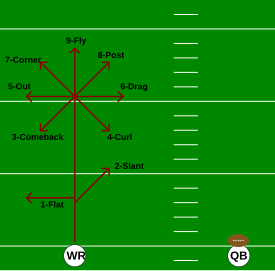
A route is a pattern or path that a receiver in gridiron football runs to get open for a forward pass.[1] Routes are usually run by wide receivers, running backs and tight ends, but other positions can act as a receiver given the play.
One popular way to organize routes is with a "route tree". A route tree is a way to show all the various routes with one diagram.[2]
Routes
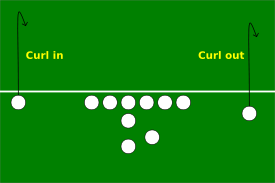
Curl
A curl route, also called a hitch or hook (sometimes a button hook), is a route where the receiver appears to be running a
The curl is a pattern used frequently by the West Coast offensive scheme, where quick and accurate passes are favored.
This route can also be used in what is called a
Drag

A drag route (also known as an in route or a dig route) is a
The use of two crossing drag routes can also be used to try to create an open receiver by using the other receiver to block the path of a defensive back in a man coverage scheme. Out and in routes are the most difficult routes to cover in man-to-man coverage, but can be dangerous plays to run because, if the defender intercepts the pass, he will often have a clear path to the end zone.
Corner
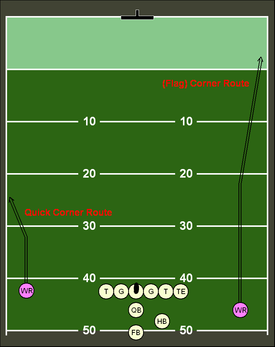
A corner route is a
Fly

A fly route, also called a streak route or go route, is a
Fly patterns can also be used to clear out space for other receivers. Generally, a fly pattern will draw the attention of both the cornerback assigned to the receiver as well as "over the top" help from a safety. This can create a large gap in coverage, allowing another receiver to run a shorter route, but then gain many yards after the catch because the safety committed to the deep receiver.
The famed "Hail Mary" play generally involves between three and five receivers all running fly routes in order to have the most chance of one of them catching the ball and scoring or at least gaining significant yardage.
Out

An out route (or down and out or jet route) is a
This route is used much more frequently near the end of each half, or when a team is running their
Post

A post route is a moderate to deep
It is designed to stretch the opposing secondary deep down the field, opening holes in the coverage over the middle. It works particularly well against secondaries that don't have more than one
To run the route effectively, a wide receiver must be adept at catching the ball in traffic, and have the vertical ability and strength to rise above the top of a safety to catch the ball.
A variant of the post pattern, in which the receiver cuts infield at a shallower angle, is called a skinny post.[14] It is designed to find a hole in deep coverage, cutting shallow inside the deep sideline defender, but not far enough to draw the middle defender.
Slant
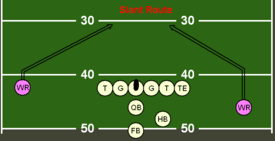
A slant route is a
Flat

A flat route is usually run by a
The QB's pass should arrive when he has not yet passed the line of scrimmage. The receiver will then turn upfield at the sideline and run straight down the field.The route is used with
Wheel
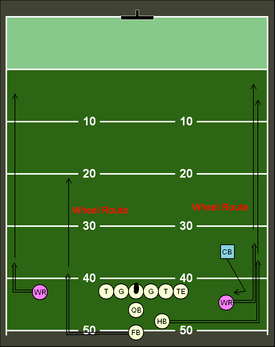
A wheel route can be run by a
This route is useful when run from the wide receiver position because the
Swing
A swing route or a flare route is run by the
Seam
The seam route
Stop-and-go
A stop-and-go, pump-and-go or a hitch-and-go is a route run by a
Jerk
A jerk route is run by a receiver. In essence, it is a shallow
Double Out
A double out is when a receiver runs 5-8 yards down field cuts outside, then cuts vertically upfield once more then cuts outside again. This route is very difficult to run and to defend due to all of the drastic changes in momentum, this route is also rarely used due to the time taken to correctly complete.
Angle route
Typically run by a running back, fullback, or tight end, the player will run out at a 45 degree angle for a few steps, then cut 90 degrees back inside.
Sail route
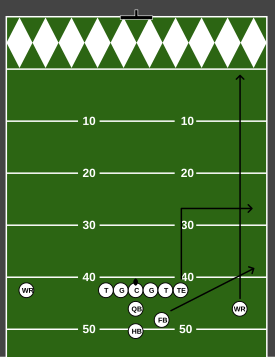
The sail route is not a route, but a combinations of routes. The sail concept is a three-level passing scheme that overloads one side of the defense while stretching the coverage vertically. Typically, the sail concept is a combination of a deep vertical route from the outside receiver, an intermediate out or christopher crossing route from the inside receiver, and a short flat route ‒ often a quick out or a swing route ‒ by the running back. This sets up a three-level read for the quarterback, with a receiver at 25-, 15- and 5- yard depths vertically.[28]
Pivot
A pivot route, also known as a shark route or a zig route, is similar to an out route, except the receiver will cut one direction, then spin 180 degrees towards the line of scrimmage then continue in the opposite direction.
Sluggo
A sluggo is run by a
Hot route
A hot route is used to escape a potential sack from a
Crossing
A crossing route or crossing pattern refers to either a
Chair
The chair route or out-and-up was pioneered by
References
- ^ "Glossary". NFL-360. Retrieved 13 April 2016.
- ^ Nogle, Kevin (June 20, 2016). "Football 101: The route tree". The Phinsider.
- ^ "10 Football Passing Routes Explained". 9 November 2015.
- ^ "American Football Passing Patterns".
- ^ "500(FUMBLE!) - Sporting Charts". www.sportingcharts.com.
- ^ Staff, Xs Os. "Pass Routes 101 | Football".
- ^ ISBN 978-0-7360-5456-0.
- ISBN 978-0-88011-662-6.
- ^ "500(FUMBLE!) - Sporting Charts". www.sportingcharts.com.
- ^ Williams, Travis (May 12, 2014). "Understanding the Route Tree, Part II". Field Gulls.
- ^ Bowen, Matt. "NFL 101: Breaking Down the Basics of the Route Tree". Bleacher Report.
- ^ "How to Run an Out Route - top wide receiver training". www.topwrtraining.com. Archived from the original on 2015-09-20.
- ^ "WR Basics: Routes and the Passing Tree". Shakin The Southland. March 22, 2010.
- ^ "Chalk Talk: Skinny-Post versus Traditional-Post Route | MidValleySports.Com".
- ^ "Slant Route - top wide receiver training". www.topwrtraining.com. Archived from the original on 2016-03-13.
- ^ "500(FUMBLE!) - Sporting Charts". www.sportingcharts.com.
- ^ "500(FUMBLE!) - Sporting Charts". www.sportingcharts.com.
- ISBN 9780736062619– via Google Books.
- ISBN 9781516846740– via Google Books.
- ^ Staff, Xs Os. "Pass Routes 101 - Football".
- ^ "ITP Glossary: Swing Route - Inside The Pylon". 19 February 2016.
- NFL.com.
- ^ "Seam Route Definition - Sporting Charts".
- ^ "Learning Seams And Soft Spots Against Zone Coverage - Football Tutorials". Football Tutorials. 10 October 2011.
- ^ "Prepqb.com". www.prepqb.com.
- ^ Neumann, David (September 24, 2014). "All-22 of the 49ers new 5-WR sets". Niners Nation.
- ^ "Anatomy of a Play: Royal times two". NFL.com.
- ^ "ITP Glossary: Sail Concept". 24 November 2015.
- ^ "Pass Routes 101 - Football". www.xsosfootball.com.
- ^ Brown, Chris B. (17 August 2012). "Matt Barkley and USC's "Sluggo Seam" Play".
- ISBN 9780880116626.
- ^ George, Thomas (25 January 1997). "The Passing Matchup: Quick Slant vs. Cross". The New York Times.
- ^ "Route Breakdown: Crossing Routes | PFF News & Analysis | PFF".
- USAtoday.
- ^ "Wide receiver patterns". The Football Times. 9 November 2005. Archived from the original on 5 April 2016.
